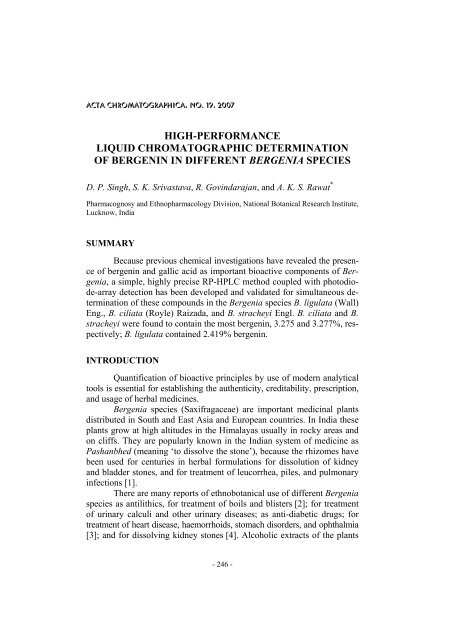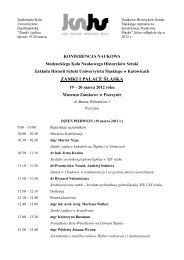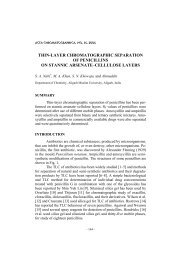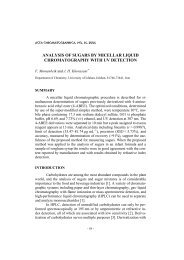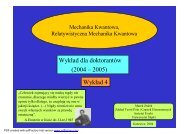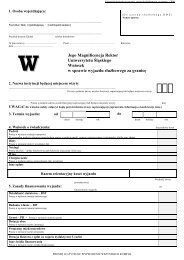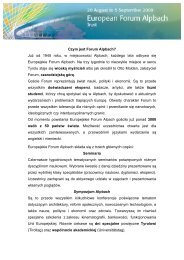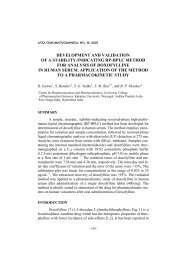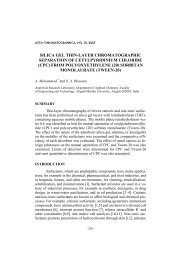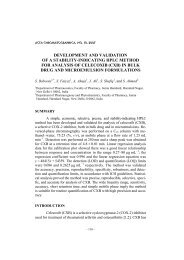High-performance liquid chromatographic determination of bergenin ...
High-performance liquid chromatographic determination of bergenin ...
High-performance liquid chromatographic determination of bergenin ...
You also want an ePaper? Increase the reach of your titles
YUMPU automatically turns print PDFs into web optimized ePapers that Google loves.
have been shown to have analgesic, anti-inflammatory, and diuretic properties[5]. Other pharmacological claims include antibacterial [6], antiinflammatory[7], and anti-tussive activity <strong>of</strong> B. ciliata [8], and anti-viral[9] and antilithiatic [10] activity.Previous chemical investigations <strong>of</strong> these plants have revealed thepresence <strong>of</strong> β-sitosterol-D-glucoside [11], <strong>bergenin</strong> [12], α-afzelechin [13],leucocyanidin, gallic acid [14], methyl gallate, catechin [15], and pashaanolactone[16]. Bergenin is reported to have anti-inflammatory [17], antitussive[18], anti-HIV [19], antiarrhythmic [20], and neuroprotective [21] activity.Because <strong>of</strong> their great importance it is important to identify whichBergenia species contain most <strong>bergenin</strong>, so the most potent plant speciesis used in herbal formulations and has the strongest desired effect. A simpleand highly precise RP-HPLC method with photodiode-array (PDA) detectionhas therefore been developed and validated for simultaneous analysis<strong>of</strong> the bioactive molecules <strong>bergenin</strong> and gallic acid in three different Bergeniaspecies, viz. B. ligulata (Wall) Eng., B. ciliata (Royle) Raizada, andB. stracheyi Engl. The method can also be used for quality control andstandardization <strong>of</strong> the species, to identify the species used in a formulation.EXPERIMENTALChemicalsBergenin and gallic acid were obtained from Sigma–Aldrich (Steinheim,Germany). HPLC-grade acetonitrile, water, and phosphoric acid werefrom Merck (Darmstadt, Germany).Plant Material and ExtractionRhizomes <strong>of</strong> three different Bergenia species, B. ligulata (Wall)Eng., B. ciliata (Royle) Raizada, and B. stracheyi Engl. were collectedfrom Almora (Uttracnhal, India). The specimens were authenticated and avoucher specimen <strong>of</strong> each (LWG 222437BC; LWG 222438BL; LWG222439BS, 2004) was deposited in a herbarium. Samples <strong>of</strong> air-dried (45–55°C) powdered rhizome from the three Bergenia species (1.0 g) wereextracted with 3 × 10 mL methanol. The extracts from each species wereseparately combined, concentrated by rotary evaporation (Büchi, USA) atlow temperature (45°C), and then freeze-dried (Freezone 4.5; Labconco,USA) under high vacuum (133 × 10 4 mBar) at −40 ± 2°C to furnish resi-- 247 -
dues equivalent to 5.0, 8.833, and 13.83%, respectively, <strong>of</strong> the dry mass <strong>of</strong>the original plant sample.To identify peaks present in the blank mobile phase was treated inthe same way.Qualitative and Quantitative HPLC Analysis <strong>of</strong> BergeninChromatography was performed with Waters (Milford, MA, USA)515 pumps, an online degasser, a Waters pump-control module, a Rheodyne7725 injection valve with a 20-µL loop, a Waters 2996 photodiodearray detector, and Waters Empower s<strong>of</strong>tware. Compounds were separatedon a 150 mm × 3.6 mm i.d., 5-µm particle, Waters Symmetry column protectedby a guard column <strong>of</strong> the same type.An HPLC fingerprint pr<strong>of</strong>ile was established for the phenolic fraction.Elution was performed at a flow rate <strong>of</strong> 1 mL min −1 with a gradientprepared from water–phosphoric acid 99.7:0.3 (v/v) (component A) andacetonitrile–water–phosphoric acid 79.7:20:0.3 (v/v) (component B). The gradientwas: 0–5 min, 88–85% A; 5–10 min, 85–75% A; 10–20 min, 75–70%A. Typical chromatograms obtained under these conditions are shown inFig. 1.CalibrationThe amounts <strong>of</strong> the active compounds were determined by use <strong>of</strong>calibration plots established by chromatography <strong>of</strong> gallic acid and <strong>bergenin</strong>standards at seven different concentrations ranging from 2.5 to 200 µg mL –1 .Each solution was chromatographed in triplicate. The corresponding peakareas were plotted against the concentration <strong>of</strong> the phenolic compound injected.Peaks were identified by comparison <strong>of</strong> retention times and UVabsorption spectra with those <strong>of</strong> standards.ValidationSelectivity and Peak PuritySelectivity was checked by using an extract <strong>of</strong> Bergenia species anda mixture <strong>of</strong> available standards and optimizing separation and detection.The purity <strong>of</strong> the peaks was checked by acquisition <strong>of</strong> spectra (λ = 200–400 nm) by use <strong>of</strong> the PDA detector and use <strong>of</strong> multivariate analysis.Spectra were acquired at the upslope, apex, and downslope <strong>of</strong> each peak,computer normalized, and superimposed. Peaks were considered pure whenthere was coincidence between the three spectra (match factor ≥98%).- 248 -
2.001StdAU1.0020.000.100.00 5.00 10.00 15.00 20.00 25.00Minutes2BCAU0.0510.000.150.00 5.00 10.00 15.00 20.00 25.00Minutes2BS0.10AU0.0510.000.140.120.100.080.00 5.00 10.00 15.00 20.00 25.00Minutes2BLAU0.060.040.020.001Fig. 1-0.020.00 5.00 10.00 15.00 20.00 25.00MinutesChromatograms obtained from Bergenia species (Std, standard; BC, B. ciliate; BS, B. stracheyi;BL, B. ligulata) at 272 showing 1, gallic acid; 2, <strong>bergenin</strong>- 249 -
Linearity, and Limits <strong>of</strong> Detection and QuantificationThe linearity <strong>of</strong> the detector response for the standards was assessedby linear regression analysis <strong>of</strong> the amounts <strong>of</strong> each standard (µg) andthe area <strong>of</strong> the corresponding peak on the chromatogram. Linearity wasalso confirmed for extracts. After <strong>chromatographic</strong> separation, the peakareas obtained were plotted against extract concentration by linear regressionanalysis.Limits <strong>of</strong> detection and quantification were determined as the amountsfor which the calculated signal-to-noise ratios were approximately 3:1 and10:1, respectively.StatisticsWhen applicable, one-way or two-way analysis <strong>of</strong> variance (SPSS11.0 for Windows) was used to assess the observed differences in phenoliccontent. Differences were considered to be statistically significant whenthe P value was
elution were not observed (match factors ≥95%). Linearity and limits <strong>of</strong>detection (LOD) and quantification (LOQ) were evaluated for quantitativepurposes (Table II). LOD for <strong>bergenin</strong> and gallic acid were 1.16 and 0.66µg mL −1 and LOQ were 3.9 and 4.2 µg mL −1 , respectively, implying themethod was suitable for quantification <strong>of</strong> these compound. R 2 values forthe compounds were >0.98, confirming the linearity <strong>of</strong> the method. Themethod can therefore be regarded as suitable for quality control and standardization<strong>of</strong> Bergenia species.Table IIRetention times, correlation coefficients and linear range from regression analysis, andlimits <strong>of</strong> quantification (LOQ) and detection (LOD)Compound t R (min) a R 2 Linear range LOD LOQ(µg mL −1 ) (µg mL −1 ) (µg mL −1 )Gallic acid 5.91 ± 0.12 0.990 10–200 0.66 4.2Bergenin 11.06 ± 0.23 0.957 5–50 1.16 3.9a Means from ten replicates ± SDThese results suggest B. ciliata and B. stracheyi are better sources<strong>of</strong> <strong>bergenin</strong> than B. ligulata and that their biological activity will be greater.ACKNOWLEDGEMENTThe authors are grateful to Dr Rakesh Tuli, Director, NBRI forproviding the facilities to conduct this research work.REFERENCES[1] L.V. Asolkar, K.K. Kakkar, and O.J. Chakre, Glossary <strong>of</strong> IndianMedicinal Plants with Active Principles. PID, CSIR, New Delhi,1992, p. 122[2] K.K. Singh, Indian Int. J. Pharmacol., 35, 105 (1997)[3] S.K. Kapur, J. Econ. Tax. Bot., 17, 395 (1993)[4] P.B. Singh and B.S. Aswal, Bull. Med. Ethnobot. Res.,13, 172 (1992)- 251 -
[5] N.K. Gehlot, V.N. Sharma, and D.S. Vyas, Indian. J. Pharmacol.,8, 92 (1976)[6] S. Sinha, T. Murugesan, K. Maiti, J.R. Gayen, B. Pal, M. Pal,and B.P. Saha, Fitoterapia, 72, 550 (2001)[7] S. Sinha, T. Murugesan, K. Maiti, J.R. Gayen, B. Pal, M. Pal,and B.P. Saha, J. Pharm. Pharmacol., 53, 193 (2001)[8] S. Sinha, T. Murugesan, M. Pal, and B.P. Saha, Phytomedicine,8, 298 (2001)[9] M. Rajbhandari, U. Wegner, M. Julich, T. Schopke, and R. Mentel,J. Ethnopharmacol., 74, 251 (2001)[10] T.S. Garimella, C.I. Jolly, and S. Narayanan, Phytother. Res.,15, 351 (2001)[11] M.K. Jain and K. Gupta, J. Indian Chem. Soc., 39, 559 (1962)[12] C.P. Baht, R. Murari, M.R. Parthasarathy, and T.R. Seshadri, IndianJ. Chem., 12, 1038 (1974)[13] A.P. Tucci, M.F. Delle, B. Marini, and B. Giovanni, Ann. SuperSanita., 5, 555 (1969)[14] S.K. Chauhan, B. Singh, and S. Agrawal, JAOAC Int.,83, 1480 (2000)[15] B.S. Dixt and S.N. Srivastava, Indian J. Nat. Prod., 5, 24 (1989)[16] U.D. Chandra Reddy, A.S. Chawla, D. Mundkinajeddu, R. Maurya,and S.S. Handa, Phytochemistry, 47, 907 (1998)[17] T. Swarnalakshmi, M.G. Sethuraman, N. Sulochana,and R. Arivudainambi, Curr. Sci., 53, 917 (1984)[18] X. Piegen, Traditional Experience <strong>of</strong> Chinese Herb Medicine. ItsApplications in Drug Research and New Drug Searching.In: J.L. Beal, E. Reinhard (Eds) Natural Products as MedicinalAgents, Hippokrates, Stuttgart, 1980[19] S. Piacente, C. Pizza, and N. Detommasi., J. Nat. Prod.,59, 565 (1996)[20] H.L. Pu, X. Huang, J.H. Zhao, and A. Hing, Planta Med.,68, 372 (2002)[21] H. Takahashi, M. Kosaka, Y. Watanabe, K. Nakade,and Y. Fukuyama, Bioorg. Med. Chem., 11, 1781 (2003)- 252 -


